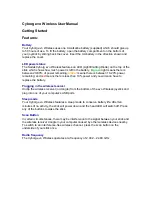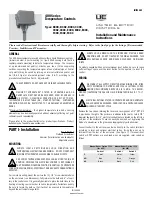
IL05003015E.pdf
time is 4.7us or
0~1,000 times
(Setting by D1021)
On
→
Off
<30us
<1us (Y10, Y11 only)
4
MODEL NAME & I/O CONFIGURATION
Model
Input/Output Specification
I/O Configuration
Power
Input Unit
Output Unit
Points
Type
Points
Type
ELC-PH12NNDT 24VDC
6
24VDC
Sink/Source
X0~X5
2
Transistor
Y0, Y1
S/S
X0
X1
X2
X3
X4
X5
X10
X11
C0
Y0
C1
Y1
C2
Y10
C3
Y11
2
24VDC
Sink/Source
Hi-speed
X10, X11
2
Transistor
Hi-speed
Y10, Y11
5
INSTALLATION & WIRING
5.1 Installation of the DIN rail
The ELC can be secured to a cabinet by using the DIN rail that is 35mm high with a depth of 7.5mm. When
mounting the ELC on the DIN rail, be sure to use the end bracket to stop any side-to-side motion of the ELC, thus
to reduce the chance of the wires being pulled loose. At the bottom of the ELC is a small retaining clip. To secure
the ELC to the DIN rail, place it onto the rail and gently push up the clip.
To remove it, pull down the retaining clip and gently pull the ELC
away from the DIN rail. As shown on the right:
When installing the ELC, make sure that it is installed in an
enclosure with sufficient space (as shown on the right) to its
surroundings so as to allow heat dissipation.
D
D
D
D
E
L
C
D>50mm
5.2 Wiring
22-16AWG
<1.5mm
1. Please use 22-16AWG (1.5mm) wiring (either single or multiple core) for
I/O wiring terminals. The specification for the terminals is as shown on the
left. ELC terminal screws should be tightened to 1.95 kg-cm (1.7 lb-in). Use
Copper Conductor Only, 60/75
°
C.
2. I/O signal wires or power supply should not run through the same multi-wire
cable or conduit.
3. DO NOT install the ELC on a shelf or on an unstable surface.
5.3 Power Input Wiring
1. When DC voltage is supplied to the ELC, make sure the power is at terminals 24VDC and 0V (power range is
20.4VDC~28.8VDC). When voltage is lower than 20.4VDC, ELC will stop operating, all outputs will turn OFF
and the ERROR LED will flash continuously.
2. If the power-cut time is less than 10ms, the ELC still operates unaffectedly. If the power-cut time is too long or
the power voltage drops, the ELC will stop operating and all the outputs will be Off. Once the power is restored,
the ELC will return to operate automatically. (There are latched auxiliary relays and registers inside of the ELC,
please be aware when programming.)
DC Input Type
2A
20.4V~28.8V
DC/DC
+5V
S/S
X0
X1
X2
24V
0V
GND
ELC
5.4 Output point wiring
Y0
LED
C0
TRANSISTOR OUTPUT
LOAD
ELC-**-**NN T
*
< 0.5A
T
ri
g
g
er c
irc
ui
t
1. ELC-PH series have only one transistor output module. See “Function
Specifications” for their specifications.
2. Please watch out the connection of common terminals whilewire the
outputs. when wiring ELC-PH12NNDT,output terminal Y0 uses one
common terminal C0, Y1 uses C1, Y10 uses C2, and Y11 uses C3, as
shown below:
C0 Y0
C1 Y1
Transistor
C2 Y10
C3 Y11
When output points are enabled, their corresponding indicators on the
front panel will be on
3. Isolation circuit: The optical coupler is used to isolate signals between
the circuit inside ELC and input modules.
5.5 The Transistor Output Circuit Wiring
MC1
2
3
1
C0 Y0
Y1 C2 Y10 C3 Y11
4
5
3
4
C1
1 DC power supply
2 Emergency stop
3 Circuit protection fuse
4 Flywheel diode + inductive load
5 Manually exclusive output: Uses external circuit and forms
an interlock, together with ELC internal program, to ensure
safe protection in case of any unexpected errors. *1
*1: Transistor outputs use internal zener diode(39V) as protection circuitry. When driving the
inductive load with transistor output, a reverse-current protection diode can be installed in parallel
with the load if necessary.
The reverse-current protection diode needs to satisfy the following specifications.
- The diode is rated for maximum reverse voltage of 5 to 10 times the load voltage.
- The forward current is more than the load current.
5.6 Input/Output Wiring
24VDC
S/S
X0
X1
X5
X10
X11
Y0
C0
Y1
C1
Y10
C2
C3
Y11
LOAD
CH0
CH1
100KHz
100KHz
100KHz
100KHz
30mA~0.3A
5VDC~30VDC
High-speed pulse
inputs
High-speed pulse
inputs
X10 and X11 can be used as common inputs
or inputs of high-speed counter
High-speed pulse
outputs
High-speed pulse
outputs
Y10 and Y11 can be used as common outputs or
high-speed pulse outpus used with position control
Sp
ec
ia
l hi
gh-
s
p
e
e
d
co
u
n
te
r h
a
n
d
le
s
C
a
lc
ul
a
tio
n
o
f H
igh
-s
pe
ed
p
ul
s
e o
ut
put
6
HIGH-SPEED PULSE INPUT/OUTPUT FUNCTION
Additional high-speed input counters of ELC-PH series
1-phase 1 input
1-phase 2 inputs
A/B phase input
C235 C236 C237 C238 C239 C240 C241 C242 C243 C244 C245 C246 C247 C249 C250 C251 C252 C254
X0
U/D
U/R
U/D
U
U
U A
A
A
X1 U/D R R D D D B B B
X2
U/D
U/D
R
R R
R
X3
U/D
R S S S
X
4
D
U/
X
5
D
U/
X10
U/D
U
X11
U/D
D
Additional high-speed counters C243, C245 and C250 correspond to count input X10 and X11. The counters
correspond to X0~X5 are the same as PA/PC series.
1.
Usage Explanation
a)
When X10 and X11 is set to 1-phase 1 input or 2 inputs, frequency for single input can up to 100KHz and
130KHz for total bandwidth.
b) The ON/Off of M1243 can decide count up/down of C243 and the ON/Off of M1245 can decide count
up/down of C245.
c) When using C243 or C245, C250 will be invalid. In the same way, C243, C245 are invalid when using C250.
2.
The usage of instruction comparison reached output
There are at most two high-speed comparison instructions when DHSCS and DHSCR use additional
high-speed counters.
Ex: when instruction DHSCS D0 C243 Y10 is used, only one instruction DHSCR D2 C243 Y10 or DHSCS D4
C245 Y10 can be used.
a) When DHSZ uses additional high-speed counter, only one comparator setting can be used.
b) The setting number of high-speed comparison instruction that provided by PC/PA won’t reduce due to
additional high-speed counter.
c) It is recommended to use with Y10 or Y11 when high-speed comparison instruction (DHSCS) needs
high-speed response output. If using other common devices, the delay time will be at most one scan period
setting or clear. When setting interrupt I0x0, C243 corresponds to I020, C245 corresponds to I040 and C250
corresponds to I060.
The clear output device of high-speed comparison instruction (DHSCR) allows to clear counter device. But
only the same counter in one instruction can be cleared. For example: DHSCR K10 C243 C243. Besides,
only three special high-speed counters (C243, C245 and C250) can use this function.
7
TRIAL RUN
■
Preparation
1.Prior to applying power, please verify that the power lines and the input/output wiring are correct. And be
advised not to supply AC110V or AC220V into the I/O terminals, or it might short-circuit the wiring and
would cause direct damage to the ELC.
2.After using the peripheral devices to write the program into the ELC and that the ERROR LED of the ELC
is not on, it means that the program in use is legitimate, and it is now waiting for the user to give the
RUN command.
3.Use ELC-HHP to execute the forced On/Off test of the output contact.
■
Operation & Test
If the “ERROR” LED of the ELC is not blinking, use RUN/STOP switch or the peripheral devices (ELC-HHP or
ELCSoft) to give the RUN command, and the RUN indicator will then be on. If the “RUN” LED is not on, it indicates
that there is no program inside the ELC.
ELC-HHP could be utilized to monitor the settings and the registered values of the timer (T), the counter (C) and the
data register (D) during operation, and moreover, to force the output contacts to conduct the On/Off action. If the
ERROR LED is on (but not blinking), it means that the setting of the user’s program has exceeded the preset
overtime limit. (The ELC is at this moment back to STOP automatically)
■
ELC Input/Output Reaction Time
The total reaction time from the input signal to the output operation is calculated as follows:
Reaction Time = input delay time + program scan time + output delay time
Input delay time
X0~X5: 10ms (factory default), 0~20ms adjustable. Refer to the usage of special
registers D1020. X10, X11: 0 times (factory default), 0~1,000 times adjustable.
Refer to the usage of special registers D1021.
Program scan time
Please refer to the usage of special register D1010.
Output delay time
Transistor module: 20~30us.
■
Basic Commands and Application Commands of the ELC:
1. The basic commands and the application commands of the ELC of this series are totally applicable to the
ELC. Refer to the ELC Application Technique Manual for relevant basic commands and application
commands.
2. The ELC-HHP handheld programming panel and the ELCSoft (Windows version) editing program of the
ladder diagram are both good for use with the ELC. Also, the ELC could connect with the
ELC-PH12NNDT through specific transmission wire to execute the program transmission, the ELC control
and the program monitoring.
7
TROUBLESHOOTING
Judge the errors by the indicators on the front panel. When errors occurred on ELC, please check:
☼
“POWER” LED
There is a “POWER” LED at the front of the ELC. When the ELC is powered On, the green LED light will be on.
☼
ELC “RUN” LED
Identify the status of the ELC. When the ELC is in operation, this light will be on, and users could thus use
ELC-HHP or the editing program of the ladder diagram to give commands to make the ELC “RUN” or “STOP”.
☼
“ERROR” LED
If incorrect programs are input to the ELC, the indicator will blink. Please check D1004 (Error code) and D1137
(Error step number).
When the ERROR LED is on (not blinking), it indicates that the execution time of the program loop has





















